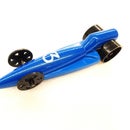Introduction: Skateboard Rack
The purpose of this skateboard rack was to solve our ongoing problem of too many students carrying their skateboards around campus.
This skateboard rack can be used to store your skateboards in a wall mounted fashion. It is modular in the sense that you can expand it to hold as many skateboards as you want.
Step 1: Gather Your Materials
The materials that are needed to make this skateboard rack are listed as followed:
- 2, 8 in. pieces of 1 in. steel square tubing
- 2, 2 ft. pieces of 1 in. steel square tubing
- 6 loops of non-galvanized steel chain, each loop with 9 links all together
- 6 chain link connectors (optional)
- 4, 1/4 in. nylon lock nuts
- 4, 3 in. long 1/4 in. screws
- 6, 33 in. cold-rolled steel tubes
- 1, 24 x 11 1/2 x 3/4 wood board
Note: In the pictures you will see in the steps later, disregard the steel o-rings on the rack. They were a design modification that we replaced with the steel chain.
Step 2: Building the Fame of Your Rack
So, to assemble the frame of your rack, you are going to need your 4 pieces of square inch tubing. What you want to do is take take your two shorter pieces and connect them in a rectangular shape. The edges of the shorter pieces should be flush with the edges of the long pieces as demonstrated in the pictures above. The next thing you want to do is weld your pieces together along the circled edges. A complete weld is not necessary, since we tack welded the edges. Once you have your frame welded together, you are ready to move onto the next step.
Step 3: Bending Your Rods
Now for the next step is to bend the steel tubes. To do that, we used a hydraulic tube bender. What you want to do is start the bend about 10.5 inches in. The bend has to be at about 158 degrees and will look something like the picture above. We created a jig to help with our bends and make sure the other rods are shaped the same. The jig is completely optional, but it does help with replicating the tubes. A picture of our jig and our hydraulic bender has been provided as well.
Step 4: Cutting the Ends of Your Rods
To cut the ends of our rods, we used a circular band saw and another jig that we created out of a block of wood. The angle that we decided to cut the rods at was about a 30 degree cut on both ends. This would give you the desired angle of 60 degrees to mount the rods on the frame. As we were cutting the rods, we encountered a problem where the cuts weren't flush with each other. We created a second wooden jig to help get our 30 degree cut and have them in line with each other. Above is a picture of the jig we used. This jig is also optional, is highly recommended to achieve the best results.
Step 5: Welding Your Rods to the Frame
Moving on, we then tack welded the rods to the frame. To do this, you will need to measure from the long end of the square tubing 2 inches and make a line going across. You will then need to make 5 more lines, each four inches apart, leaving you with 2 more inches at the end. Line up the edge of the rod to the line as shown above in the picture. The line is drawn in red because after the weld, it was difficult to see the line. The tip of the rod should be on the line to make sure everything is evenly spaced out. Once everything has been tack welded, do one final check-up to make sure everything is were you want it to be. When you're ready, weld the rod completely to the frame.
Step 6: Now for a Fresh Coat of Paint
For paint, we did two coats of primer and two coats of black paint. The color of the rack is completely optional, so pick your favorite color and spray it on there.
Step 7: Drill Some Holes to Mount This Rack
Now for the holes, you are going to need your 3 in. 1/4 in. screws and your 1/4 in. nuts. What you will need to do is take drill, then find the appropriate drill bit and drill through the metal. This will take a while! Use the setting with a high torque. Once you drill the holes in the metal, line up the board and drill through the board so that the screw slide smoothly through the holes. Twist the nut on to the screw so that the wooden board is securely attached. If the screw is larger than the wooden board, use a dremel to cut away the excess amount.
Step 8: Add Your Chain
The final step to making this rack is adding your chain. Grab one chain link with 8 links and use a chain link connector to connect them AFTER you put the chain around the loop. The reason that using the chain link connectors is optional is because you can also weld the links together. Keep in mind that if you chose to weld the chains together, the chain HAS to be non-galvanized steel because other types of chain will emit toxic fumes while welding them. Also if you weld the chains together, instead of 8 links, you will need nine.













